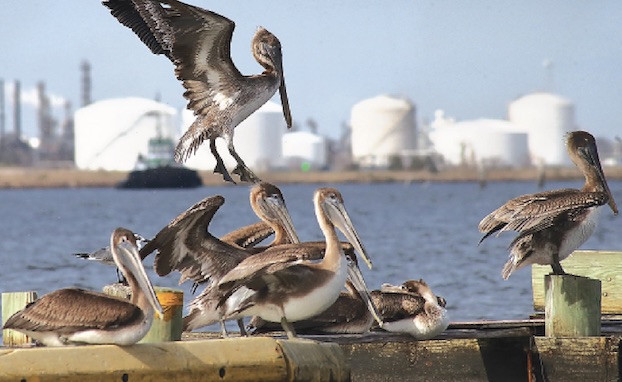Louisiana’s state bird puts on a show for area spectators
Published 6:31 am Sunday, January 7, 2024

- Brown pelicans congregate on a wooden pier at the Israel LaFleur Boat Launch Monday. (Donna Price / American Press)
Watching a brown pelican dive down to catch a meal, plunging head-first into the water, is a sight to see. Many visitors to Prien Lake Park and Israel LaFleur Boat Launch have witnessed the diving birds splashing down into the water due to the numerous brown pelicans that have been frequenting the area.
On Monday, the birds were congregating on an old wooden pier at the boat launch near the I-210 bridge. Several were also taking to the skies over the waters of Prien Lake to look for fish.
Pelicans will often feed in groups, diving in unison. Plunging downward as one unit, the birds appear to rival any Summer Olympics synchronized divers performance.
Brown pelicans use their pouch and their keen eyesight to catch fish. Flying over the water, they can spot a school of fish from as high as 100 feet up. When it sees fish, the pelican folds back its wings, dives into the water, and emerges with a mouthful of fish if they’re lucky. When it catches fish, a pelican holds the catch in its pouch and lets the water drain from the corners of its mouth before swallowing.
The pouch is attached to the the birds long beak. The beak, approximately nine inches in length, has a hooked tip at the end. The large naked-skin pouch, suspended from the lower half of the bill, holds two or three times more than the bird’s stomach—about a gallon of water and fish.
Brown pelicans eat up to four pounds of fish each day. Menhaden, herring, sheepshead, pigfish, mullet, minnows and silversides are favorites.
The Brown pelican (Pelecanus occidentalis) is one of seven species of pelicans. It is the only dark pelican, and the only one that plunges from the air into the water to catch its food. Weighing in at between six and seven pounds, the brown pelican is also the smallest species of pelican. These birds have a lifespan of 15 to 25 years.
The brown pelican is also a quiet bird. Adults will make an occasional low croak or grunt, and babies may squeal, but for the most part the birds are usually silent.
The brown pelican was designated the official state bird of Louisiana in 1966, which is ironic because the birds completely disappeared from the state that year. Pesticide use caused pelicans to stop nesting along the Louisiana coast beginning in 1961. The US Fish and Wildlife Service listed the brown pelican as an endangered species in 1970.
In 1972, the U.S. Environmental Protection Agency banned the use of DDT. Since that time, populations of pelicans have recovered and expanded. The recovery has been so successful that brown pelicans were taken off the endangered species list in 2009.
Louisiana’s attempt to re-populate its coastline by transporting pelican fledglings from Florida was also successful. The Federal Government declared the brown pelican “recovered” in Louisiana in 1995.
Still, coastal erosion, the 2010 BP Deepwater Horizon oil spill, and multiple hurricanes have reduced the nesting and breeding grounds for the birds along the coast.
a
Sources: https://statesymbolsusa.org, https://www.audubon.org, Smithsonian’s National Zoo & Conservation Biology institute and https://seaworld.org





